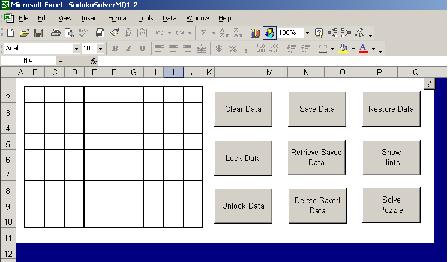
Matt Quinn sent along this version of a sudoku solver, which is also a logic-only solver, and has a hints feature and a load of other buttons. It's a more muscular program than mine, for sure, more code, faster solve, more complete logic. Sudoku Excel Download – Puzzle Solver – Free Game Help. Sudoku Solver – Excel Games Puzzle Sudoku is one of the famous Math games that will test your memory capability. Here is the list of instructions about how to play this game. A standard Sudoku is a 9×9 Tile game with 9 Rows, 9 Columns and nine 3×3 matrices/blocks.
A typical Sudoku puzzle A standard contains 81 cells, in a 9×9 grid, and has 9 boxes, each box being the intersection of the first, middle, or last 3 rows, and the first, middle, or last 3 columns. Each cell may contain a number from one to nine, and each number can only occur once in each row, column, and box. A Sudoku starts with some cells containing numbers ( clues), and the goal is to solve the remaining cells. Proper Sudokus have one solution. Players and investigators may use a wide range of computer algorithms to solve Sudokus, study their properties, and make new puzzles, including Sudokus with interesting symmetries and other properties. There are several computer algorithms that will solve most 9×9 puzzles ( n=9) in fractions of a second, but occurs as n increases, creating limits to the properties of Sudokus that can be constructed, analyzed, and solved as n increases. Main article: Some hobbyists have developed computer programs that will solve Sudoku puzzles using a backtracking algorithm, which is a type of brute force search.
Backtracking is a depth-first search (in contrast to a breadth-first search), because it will completely explore one branch to a possible solution before moving to another branch. Although it has been established that approximately 5.96 x 11 26 final grids exist, a brute force algorithm can be a practical method to solve Sudoku puzzles.
A brute force algorithm visits the empty cells in some order, filling in digits sequentially, or backtracking when the number is found to be not valid. Briefly, a program would solve a puzzle by placing the digit '1' in the first cell and checking if it is allowed to be there.
If there are no violations (checking row, column, and box constraints) then the algorithm advances to the next cell, and places a '1' in that cell. When checking for violations, if it is discovered that the '1' is not allowed, the value is advanced to '2'.
If a cell is discovered where none of the 9 digits is allowed, then the algorithm leaves that cell blank and moves back to the previous cell. The value in that cell is then incremented by one.

3d lenticular software with crack and keygen finder. This is repeated until the allowed value in the last (81st) cell is discovered. The animation shows how a Sudoku is solved with this method. The puzzle's clues (red numbers) remain fixed while the algorithm tests each unsolved cell with a possible solution. Notice that the algorithm may discard all the previously tested values if it finds the existing set does not fulfil the constraints of the Sudoku. Advantages of this method are: • A solution is guaranteed (as long as the puzzle is valid). • Solving time is mostly unrelated to.